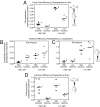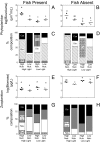Light, nutrients, and food-chain length constrain planktonic energy transfer efficiency across multiple trophic levels
- PMID: 19011082
- PMCID: PMC2587603
- DOI: 10.1073/pnas.0805566105
Light, nutrients, and food-chain length constrain planktonic energy transfer efficiency across multiple trophic levels
Abstract
The efficiency of energy transfer through food chains [food chain efficiency (FCE)] is an important ecosystem function. It has been hypothesized that FCE across multiple trophic levels is constrained by the efficiency at which herbivores use plant energy, which depends on plant nutritional quality. Furthermore, the number of trophic levels may also constrain FCE, because herbivores are less efficient in using plant production when they are constrained by carnivores. These hypotheses have not been tested experimentally in food chains with 3 or more trophic levels. In a field experiment manipulating light, nutrients, and food-chain length, we show that FCE is constrained by algal food quality and food-chain length. FCE across 3 trophic levels (phytoplankton to carnivorous fish) was highest under low light and high nutrients, where algal quality was best as indicated by taxonomic composition and nutrient stoichiometry. In 3-level systems, FCE was constrained by the efficiency at which both herbivores and carnivores converted food into production; a strong nutrient effect on carnivore efficiency suggests a carryover effect of algal quality across 3 trophic levels. Energy transfer efficiency from algae to herbivores was also higher in 2-level systems (without carnivores) than in 3-level systems. Our results support the hypothesis that FCE is strongly constrained by light, nutrients, and food-chain length and suggest that carryover effects across multiple trophic levels are important. Because many environmental perturbations affect light, nutrients, and food-chain length, and many ecological services are mediated by FCE, it will be important to apply these findings to various ecosystem types.
Conflict of interest statement
The authors declare no conflict of interest.
Figures





References
-
- Hairston NG, Hairston NG. Cause–effect relationships in energy-flow, trophic structure and interspecific interactions. Am Nat. 1993;142:379–411.
-
- Pauly D, Christensen V, Dalsgaard J, Froese R, Torres F. Fishing down marine food webs. Science. 1998;279:860–863. - PubMed
-
- Ware DM, Thomson RE. Bottom-up ecosystem trophic dynamics determine fish production in the northeast Pacific. Science. 2005;308:1280–1284. - PubMed
-
- Richardson TL, Jackson GA. Small phytoplankton and carbon export from the surface ocean. Science. 2007;315:838–840. - PubMed
-
- Vander Zanden MJ, Rasmussen JB. A trophic position model of pelagic food webs: Impact on contaminant bioaccumulation in lake trout. Ecol Monogr. 1996;66:451–477.
Publication types
MeSH terms
LinkOut - more resources
Full Text Sources
Other Literature Sources

